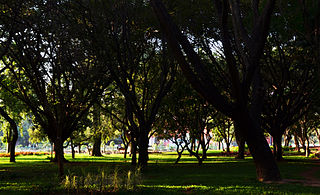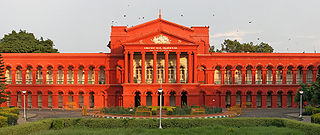
Vidhana Soudha is a building in Bangalore, India which serves as the seat of the state legislature of Karnataka. It is constructed in Neo-Dravidian style and completed in 1956.

A garland is a decorative braid, knot or wreath of flowers, leaves, or other material. Garlands can be worn on the head or around the neck, hung on an inanimate object, or laid in a place of cultural or religious importance.

Lalbagh Botanical Garden or simply Lalbagh, is a botanical garden in Bangalore, India, with an over 200-year history. First planned and laid out during the dalavaiship of King Hyder Ali, the garden was later managed under numerous British Superintendents before Indian Independence. It was responsible for the introduction and propagation of numerous ornamental plants as well as those of economic value. It also served a social function as a park and recreational space, with a central glass house dating from 1890 which was used for flower shows. In modern times, it hosts two flower shows coinciding with the week of Republic Day and Independence Day. As an urban green space along with Cubbon Park, it is also home to numerous wild species of birds and other wildlife. The garden also has a lake adjoining a large rock on which a watchtower had been constructed during the reign of Kempegowda II.

Nandi Hills is an ancient hill station built by Ganga Dynasty in the Chikkaballapur district of Karnataka state. It is 10 km from Chickballapur town and approximately 60 km from Bengaluru. The hills are near the town Nandi. In traditional belief, the hills are the origin of the Arkavathy river, Ponnaiyar River, Palar River, Papagni River and Penna River. Watching the sunrise at Nandi Hills is popular with tourists. The first ever SAARC summit hosted by India was held at Nandi Hills in 1986.

Puneeth Rajkumar, affectionately known as Appu, was an former Indian actor, playback singer, film producer, television presenter and philanthropist who worked in Kannada cinema. He was the youngest son of legendary actor and matinee idol Dr. Rajkumar. He was one of the most popular actors in Kannada cinema. He appeared as a lead in 32 films. As a child, he appeared in many films. His performances as a child actor in Vasantha Geetha (1980), Bhagyavantha (1981), Chalisuva Modagalu (1982), Eradu Nakshatragalu (1983), Bhakta Prahaladha (1983), Yarivanu (1984) and Bettada Hoovu (1985) were praised. He won the National Film Award for Best Child Artist for his role of Ramu in Bettada Hoovu. He also won Karnataka State Award Best Child artist for Chalisuva Modagalu and Eradu Nakshatragalu. Puneeth's first lead role was in 2002's Appu. In a career spanning three decades, he has won one National Film Award, four Karnataka State Film Awards, six Filmfare Awards South and five SIIMA awards. He was conferred with the Doctorate by Mysuru University. The Karnataka Government conferred the state's highest civilian award, Karnataka Ratna, to Puneeth Rajkumar on 1 November 2022, posthumously.

Cubbon Park, officially Sri Chamarajendra Park, is a landmark park in Bengaluru, located in the heart of the city in the Central Administrative Area. Originally created in 1870 under Major General Richard Sankey, then British Chief Engineer of Mysore State, it covered an area of 100 acres (0.40 km2). Subsequent expansion has since taken place and the park's area is now reported to be 300 acres (1.2 km2). It has a rich recorded history of abundant flora and fauna plantations coupled with numerous impressive and aesthetically located buildings and statues of famous personages, in its precincts.
The Kingdom of Mysore was a kingdom in southern India traditionally believed to have been founded in 1399 in the region of the city of Mysore in Karnataka. For the most part, the Wodeyar dynasty ruled the southern Karnataka region until the kingdom united with the Dominion of India in 1947. During the kingdom's history, it went through various phases of administration, with increasing foreign influence from the eighteenth century.

Bangalore City Railway Station, officially Krantivira Sangolli Rayanna Bengaluru Station, commonly known as KSR Bengaluru Station, Bengaluru City Railway Station or Majestic Railway station, is the main railway station serving the city of Bangalore, Karnataka, India. It is the busiest railway station in South Western Railway zone of Indian Railways, and is the only station classified under NSG1 category in the zone.

Lieutenant-General Sir Mark Cubbon KCB was a British army officer with the East India Company who was the Chief Commissioner of Mysore 1834 to 1861. During his tenure, he established a law and order system, introduced judicial and economic reforms and through action in all spheres of governance helped develop the economy of Mysore. He resigned from his office in 1860 due to ill-health and left for England for the first time since his arrival in India as a cadet in 1800. The administration of the Kingdom of Mysore under his leadership ensured that the 1857 rebellion had almost no impact in the region. He died in 1861 on board ship at Suez. Cubbon Road and Cubbon Park in Bangalore are named after him.

The central business district of Bangalore is the area within a 6 km radius around Vidhan Soudha. This is the center of Bangalore and was founded by Kempegowda of the Vijayanagara Empire. Most of the land is used by commercial establishments and the Indian Army with plans of skyscrapers under works. It has multiple high-rises including World Trade Center Bangalore and UB Tower. It also includes heritage properties like the Bangalore Fort and the Bangalore Pete.

The Indian Institute of Cartoonists (IIC) is an organisation based in Bangalore that serves to promote and preserve cartooning and cartoonists in India. Founded in 2001, the institute hosts the Indian Cartoon Gallery with rotating exhibits focusing on different artists. It has organised more than one hundred exhibitions of cartoons.
The Mysore Commission, also known as Commissioners' Rule or simply the Commission Rule, was a period and form of government in the history of the Kingdom of Mysore and the neighbouring province of Coorg from 1831 to 1881 when British commissioners administered the kingdom due to the deposition of Maharaja Krishnaraja Wodeyar III and later during the minority of Yuvaraja Chamaraja Wadiyar X. A board of commissioners constituted the chief executive body and provincial head of the kingdom's government. The commission began with uninstallation of Krishnaraja Wodeyar III as King in 1831 and ended with investing Chamaraja Wadiyar X as the new maharaja in 1881.

Cubbon Park is an underground metro station on the East-West corridor of the Purple Line of Namma Metro in Bangalore, India. It was opened to the public on 30 April 2016. The station is located a few metres away from one of the entrances to Cubbon Park.
The Consulate General of the Federal Republic of Germany in Bangalore represents the interests of the Government of Germany in the Indian states of Karnataka and Kerala. It was opened on 21 November 2008 in a temporary office in the central business district (CBD) of Bangalore. On 22 June 2012, the Consulate moved to its permanent premises in the corner of St. Mark's Road and Residency Road near the Bishop Cotton Girls' School. Achim Burkart is the current Consul General.
Fraser Town, Bengaluru or Mootocherry, is a locality of Bangalore Cantonment, located in the central part of the city spread over 4 km2. It was established in 1906 and is named after Stuart Mitford Fraser (1864–1963), who was the tutor and guardian of Krishna Raja Wadiyar IV, Maharaja of Mysore. Fraser Town was established to de-congest the growing Bangalore Civil and Military Station. The foundation of Fraser Town was laid in August 1910 by Mrs. F J Richards, with a commemorative plaque on the corner of Coles Road and Mosque Road.

St. Mark's Cathedral, dedicated to Saint Mark the Evangelist, is the cathedral of the Diocese of Central Karnataka of the Church of South India. The cathedral church, noted for its English Baroque architecture inspired by the 17th century St Paul's Cathedral, is located at the west end of Mahatma Gandhi Road, MacIver Town, Bangalore.

The Statue of Queen Victoria, Bangalore, is located at Queen's Park, next to Cubbon Park, Bangalore Cantonment, at the junction of 3 roads, at the border between the Cantonment and the Bangalore Pete. The statue was unveiled on 5 February 1906 by the then Prince of Wales, George Frederick Ernest Albert. The statue was raised out of funds raised by the residents of the Bangalore Civil and Military Station and contributions made by Krishna Raja Wadiyar IV, the Maharaja of Mysore. This Statue of Queen Victoria is one of the five of the original 50 statues of Queen Victoria which were installed in British India, to still stand at its original location. The statue has blossoms of jacaranda falling around. On the other end of Queen's Park is the Statue of King Edward VII.

The statue of Edward VII in Bangalore is located at Queen's Park, next to Cubbon Park, Bangalore Cantonment, at the junction of Queen's Road and Cubbon Road. The statue was unveiled in November 1919 by the then Viceroy and Governor-General of India, Frederic John Napier, Baron Chelmsford. The statue was raised out of funds raised by the residents of the Bangalore Civil and Military Station. The Statue of King Edward VII is one of the few of the original statues which were installed in British India, to still stand at its original location. The statue rises above a flowering frangipani tree. On the other end of Queen's Park is the Statue of Queen Victoria, Bangalore. The statue was designed and sculpted by Leonard Jennings of Chelsea, London.

Attara Kacheri in Bangalore, India, is the seat of the principal bench of the Karnataka High Court, the highest judicial authority in the state of Karnataka. It is a neoclassical red-painted stone and brick building in Cubbon Park, located on Dr. B. R. Ambedkar Road opposite the Vidhana Soudha. It previously housed the secretariat of the princely state of Mysore and then that of independent India's Mysore State.
Agha Aly Asker was a Persian horse trader and landowner who emigrated to Bangalore, in India, in 1824 from Shiraz, Iran. He is considered the founding father of the Persian diaspora in the city whose legacy still lives on through the various colonial buildings he constructed at the behest of the Commissioner of Mysore Sir Mark Cubbon. Aly Asker was responsible for constructing the Governor's residence, the State Guesthouse- Balabrooie, Leela Nivas off Cunningham Crescent, among many others. He is also credited with putting Bangalore on the horse-racing map.















